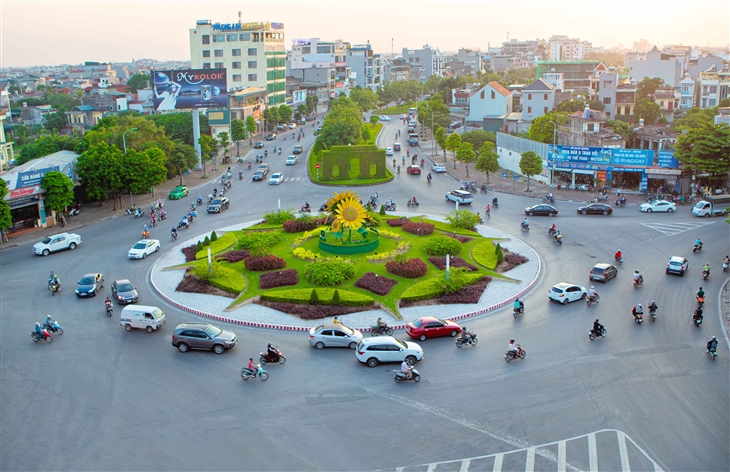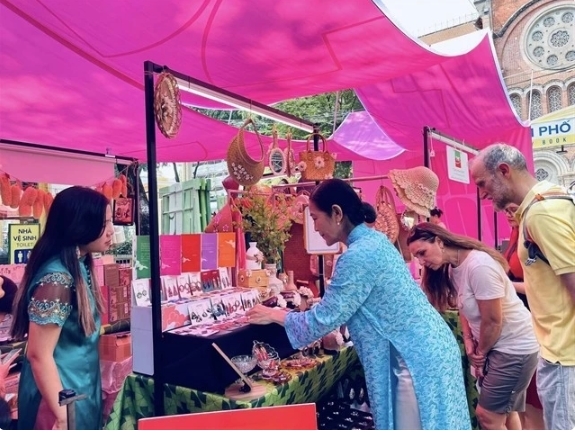Coffee export: Increasing proportion of deep processing
Monday, April 14,2025
AsemconnectVietnam - Export volume of deeply processed coffee has increased from 8.8% in 2022 to 9.6% in 2024. This is a good sign for the industry's export growth.
Increasing proportion of processed coffee for export
According to a report of Ministry of Agriculture and Environment, volume of coffee exports in March 2025 is estimated at 200,000 tonnenes with a value of 1.16 billion USD, bringing total volume and value of coffee exports in the first 3 months of 2025 to 509,500 tonnenes and 2.88 billion USD, down 12.9% in volume but up 49.5% in value compared to the same period in 2024. The average export price of coffee in the first 3 months of 2025 is estimated at 5,656 USD/tonne, up 71.7% compared to the same period in 2024.
Coffee is one of the most important export sectors of Vietnamese agriculture. The coffee industry has created jobs and income for over 600,000 farming households, with more than 2.6 million workers participating in production, equivalent to 4.8% of the country's working-age workforce.
Vietnam is the world's second largest coffee exporter after Brazil, with Vietnam's supply accounting for 19% of global market share. In 2024, coffee exports will bring in 5.48 billion USD to Vietnam, accounting for 8.7% of total agricultural, forestry and fishery exports, just behind wood and wood products, vegetables and rice.
Despite a decrease in export volume, Vietnam's coffee export turnover has still achieved impressive results in the past 3 years, due to increased export prices. Specifically, volume of coffee exports in 2022 is 1.77 million tonnes, decreasing to 1.34 million tonnes in 2024 (equivalent to a decrease of 24.3%), but the export turnover increases from 4.0 billion USD to 5.7 billion USD in the same period (an increase of 42.5%). Export turnover of coffee industry accounts for about 9.2% of total export turnover of the agricultural sector (in 2024 it is 62.5 billion USD). Vietnam still mainly exports low-value green coffee beans; deep-processed coffee (roasted, ground, instant) has a high price but export volume is only 1/10. However, proportion of deep-processed coffee is increasing.
Talking to reporters of Industry and Trade Newspaper about this issue, Mr. To Xuan Phuc - policy analyst of Forest Trends Organization - analyzed that in 2024, green coffee beans will account for about 90.4% of Vietnam's export volume, down from 2022 (91.2%). Meanwhile, export volume of deeply processed coffee has increased in recent years, from 8.8% in 2022 to 9.6% in 2024. This is a good sign for export growth of coffee industry in direction of reducing raw products and increasing deeply processed products. The average export price (FOB price) of deeply processed coffee is much higher than that of green coffee beans, for example, in 2024 it was 2.23 times higher. Transforming towards sustainability, increasing export value
Vietnamese coffee has been exported to 90 countries, of which Europe and the United States are the two largest markets. In Europe, main markets include Germany, Italy, Spain, Russia and the Netherlands, of which Germany and Italy are the two countries with the largest market shares, accounting for 14% and 10% of export output, respectively. Export output to the United States accounts for about 7.1%.
In Asian market, Japan is the largest customer of Vietnamese coffee (accounting for 8.3% of export output), followed by Philippines, China and Indonesia. Among Vietnam's main markets, Europe is the leading importer of green coffee compared to the remaining markets, the United States is the leading importer of roasted and ground coffee and Asia is the market that imports the most instant coffee.
Despite many impressive achievements, Vietnamese coffee industry is also facing many difficulties and challenges. Talking to reporters of Industry and Trade Newspaper about this issue, a representative of Vietnam Coffee - Cocoa Association said that the area of old coffee trees that need to be replanted is large, currently accounting for about 15% of total cultivated area. Proportion of coffee trees that have achieved sustainable certification is still small (about 29%).
Currently, coffee cultivation is mainly (70%) still monoculture and prioritizes productivity improvement through use of irrigation water and inputs (chemical fertilizers). Cultivation in this form is causing major environmental problems, including groundwater depletion, soil pollution and water waste.
In addition, the industry is also seriously affected by climate change. Poor habits and practices in harvesting, transporting and preserving coffee have greatly affected quality of processed and semi-processed coffee. The coffee value chain linkage is still weak and small-scale.
Although proportion of coffee put into processing has increased recently, it is still very modest (accounting for 15% of coffee output). Vietnam mainly exports raw coffee beans (accounting for 90.4% of export volume), so added value in exported products is not high.
Building and promoting brand for Vietnamese coffee at the national level is still very limited, Vietnamese coffee brand is not widely known by consumers in international market.
However, according to experts, coffee industry is currently transforming towards sustainability, improving product quality and added value, meeting increasing demand of domestic and export markets. The State has issued many policies to support the industry, including direct policies for coffee industry and related support policies, covering production, processing and trade.
To increase value of exported coffee in the coming time, Mr. Do Ha Nam - Chairman of Vietnam Coffee - Cocoa Association - said that on part of enterprises, it is necessary to diversify market; promote search and development of new export markets and make the most of advantages from signed trade agreements. On part of the authorities, it is also necessary to have timely support policies for affected enterprises, including support for finding new markets and improving production capacity. Mr. To Xuan Phuc also said that fundamental and sustainable way to increase added value of Vietnamese coffee products is through improving quality, enhancing deep processing and promoting brand building for Vietnamese coffee industry. To do so, direct or indirect policies supporting pursuit of this path need to be implemented effectively and synchronously. Policies and solutions also need to focus on solving 3 main pillars: Replanting, grafting and improving coffee; improve quality and added value of the coffee industry; strengthen linkages in production and consumption of products.
Source: Vitic/ congthuong.vn
According to a report of Ministry of Agriculture and Environment, volume of coffee exports in March 2025 is estimated at 200,000 tonnenes with a value of 1.16 billion USD, bringing total volume and value of coffee exports in the first 3 months of 2025 to 509,500 tonnenes and 2.88 billion USD, down 12.9% in volume but up 49.5% in value compared to the same period in 2024. The average export price of coffee in the first 3 months of 2025 is estimated at 5,656 USD/tonne, up 71.7% compared to the same period in 2024.
Coffee is one of the most important export sectors of Vietnamese agriculture. The coffee industry has created jobs and income for over 600,000 farming households, with more than 2.6 million workers participating in production, equivalent to 4.8% of the country's working-age workforce.
Vietnam is the world's second largest coffee exporter after Brazil, with Vietnam's supply accounting for 19% of global market share. In 2024, coffee exports will bring in 5.48 billion USD to Vietnam, accounting for 8.7% of total agricultural, forestry and fishery exports, just behind wood and wood products, vegetables and rice.
Despite a decrease in export volume, Vietnam's coffee export turnover has still achieved impressive results in the past 3 years, due to increased export prices. Specifically, volume of coffee exports in 2022 is 1.77 million tonnes, decreasing to 1.34 million tonnes in 2024 (equivalent to a decrease of 24.3%), but the export turnover increases from 4.0 billion USD to 5.7 billion USD in the same period (an increase of 42.5%). Export turnover of coffee industry accounts for about 9.2% of total export turnover of the agricultural sector (in 2024 it is 62.5 billion USD). Vietnam still mainly exports low-value green coffee beans; deep-processed coffee (roasted, ground, instant) has a high price but export volume is only 1/10. However, proportion of deep-processed coffee is increasing.
Talking to reporters of Industry and Trade Newspaper about this issue, Mr. To Xuan Phuc - policy analyst of Forest Trends Organization - analyzed that in 2024, green coffee beans will account for about 90.4% of Vietnam's export volume, down from 2022 (91.2%). Meanwhile, export volume of deeply processed coffee has increased in recent years, from 8.8% in 2022 to 9.6% in 2024. This is a good sign for export growth of coffee industry in direction of reducing raw products and increasing deeply processed products. The average export price (FOB price) of deeply processed coffee is much higher than that of green coffee beans, for example, in 2024 it was 2.23 times higher. Transforming towards sustainability, increasing export value
Vietnamese coffee has been exported to 90 countries, of which Europe and the United States are the two largest markets. In Europe, main markets include Germany, Italy, Spain, Russia and the Netherlands, of which Germany and Italy are the two countries with the largest market shares, accounting for 14% and 10% of export output, respectively. Export output to the United States accounts for about 7.1%.
In Asian market, Japan is the largest customer of Vietnamese coffee (accounting for 8.3% of export output), followed by Philippines, China and Indonesia. Among Vietnam's main markets, Europe is the leading importer of green coffee compared to the remaining markets, the United States is the leading importer of roasted and ground coffee and Asia is the market that imports the most instant coffee.
Despite many impressive achievements, Vietnamese coffee industry is also facing many difficulties and challenges. Talking to reporters of Industry and Trade Newspaper about this issue, a representative of Vietnam Coffee - Cocoa Association said that the area of old coffee trees that need to be replanted is large, currently accounting for about 15% of total cultivated area. Proportion of coffee trees that have achieved sustainable certification is still small (about 29%).
Currently, coffee cultivation is mainly (70%) still monoculture and prioritizes productivity improvement through use of irrigation water and inputs (chemical fertilizers). Cultivation in this form is causing major environmental problems, including groundwater depletion, soil pollution and water waste.
In addition, the industry is also seriously affected by climate change. Poor habits and practices in harvesting, transporting and preserving coffee have greatly affected quality of processed and semi-processed coffee. The coffee value chain linkage is still weak and small-scale.
Although proportion of coffee put into processing has increased recently, it is still very modest (accounting for 15% of coffee output). Vietnam mainly exports raw coffee beans (accounting for 90.4% of export volume), so added value in exported products is not high.
Building and promoting brand for Vietnamese coffee at the national level is still very limited, Vietnamese coffee brand is not widely known by consumers in international market.
However, according to experts, coffee industry is currently transforming towards sustainability, improving product quality and added value, meeting increasing demand of domestic and export markets. The State has issued many policies to support the industry, including direct policies for coffee industry and related support policies, covering production, processing and trade.
To increase value of exported coffee in the coming time, Mr. Do Ha Nam - Chairman of Vietnam Coffee - Cocoa Association - said that on part of enterprises, it is necessary to diversify market; promote search and development of new export markets and make the most of advantages from signed trade agreements. On part of the authorities, it is also necessary to have timely support policies for affected enterprises, including support for finding new markets and improving production capacity. Mr. To Xuan Phuc also said that fundamental and sustainable way to increase added value of Vietnamese coffee products is through improving quality, enhancing deep processing and promoting brand building for Vietnamese coffee industry. To do so, direct or indirect policies supporting pursuit of this path need to be implemented effectively and synchronously. Policies and solutions also need to focus on solving 3 main pillars: Replanting, grafting and improving coffee; improve quality and added value of the coffee industry; strengthen linkages in production and consumption of products.
Source: Vitic/ congthuong.vn
Domestic pepper prices remained unchanged on April 14, 2025
Domestic coffee prices remained unchanged on April 14, 2025
Preventing origin fraud, Ministry of Industry and Trade recommends strict management of raw materials for export production
Vietnam’s exports to US reached over 31.3 billion USD in 3 months
Wood exports in first quarter and prospects for 2025
Domestic rice prices on April 11: Retail Market Sees Strong Increase
DAILY: Vietnamese pepper prices increased by 2,000 VND/kg on April 11, 2025
DAILY: Vietnamese coffee prices exceed 120,000 VND/kg on April 11, 2025
Vietnam’s imports of goods from US increased in first quarter of 2025
Vietnam’s imports from UK increased in first quarter of 2025
Sao Ta Foods (FMC): Proactively mitigating risks, plans to distribute 2024-2025 dividends at 20%
Vietnamese specialties lead the world's best dishes made from white fish
Import and export turnover in the first 3 months of this year reached 202.52 billion USD
Imports and exports of goods in first quarter and measures to increase exports

Plan of Hai Duong province for a period of 2021 - 2030, ...
Organize space reasonably and harmoniously, focusing on connecting Hai Duong in common development space, actively contributing to the ...Plan of Hau Giang province in a period of 2021 - 2030, ...
Sustainable forestry development program in a period of ...

Art programme honouring Ao dai opens at HCM City Book ...
An art programme to honour and promote traditional cultural values and the beauty and grace of Ao dai has opened in Ho Chi Minh City. It ...From Hanoi to Brussels – a cross-cultural musical journey
Talented youngsters to enjoy int'l football ...
Tien Linh, Thuy Trang win Vietnam Golden Ball 2024
HCM City’s ao dai festival to feature mass folk dance with ...



